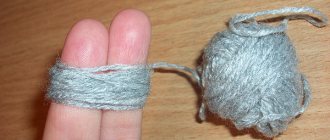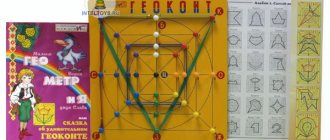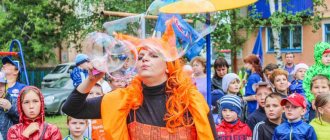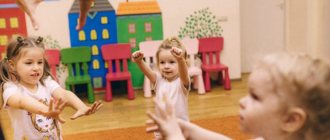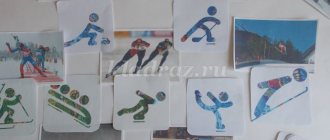On the topic: methodological developments, presentations and notes
These health sheets give a complete picture of the ongoing activities to improve the health of children every day.
To help educators, fill it out and use it.
In conditions of self-isolation, “Staying at home”, we suggest spending time usefully, instilling good habits, and adopting a healthy lifestyle. In route sheets for different types of activities prev.
Health sheet No. p/pF. I. child Health group Main diagnosis Anthropometry Furniture group beginning of the year September middle of the year ____________ end of the year ____________ height weight height weight weight 12345678910111.
Health sheet for pupils of the preschool educational institution “Kindergarten No. 195”, building 2 of the Leninsky district of Saratov, 1st junior group “Kolobok” Last name, first name Physical education group Main diagnosis.
Source
Journal of disinfection, disinfestation and deratization
To open the journal, in the “Journal” select “Premises and equipment” , then “Disinfection, disinfestation and deratization journal” .
To add or edit an entry, click or on the toolbar.
The following window will open:
Please provide the following information:
- planned dates;
- date;
- the nature of the event;
- processing agent;
- method of conduct;
- result;
- responsible person;
- special notes (if necessary).
Click to save the information.
To print the magazine, press the button. The log will be printed, the program will open the corresponding message:
Health sheet in kindergarten
The health sheet in kindergarten is usually filled out by a preschool nurse.
The health sheet contains anthropometric indicators: the child’s weight and height. It also includes health groups, information about the child’s vision, hearing, posture, as well as information about somatic diseases (if any) and several other points that are needed to monitor the child’s health in kindergarten.
Protecting children's health is the most important task for both educators and parents. In this regard, the issue of preventing childhood injuries arises.
Show your child respect for the book and teach him to handle it carefully. Maintain eye contact with your child while reading.
Accept the child as he is and love him. Hug your child at least four, and preferably eight times a day.
After waking up, children, lying in bed, do eye exercises.
If you notice signs of aggressiveness in a child, you must first try to analyze the reasons for their appearance and identify the difficulties that the child is experiencing.
Source
Child morbidity register
To open the journal:
- in the “Journal” , select “Children’s Morbidity Log” ;
- or on the toolbar, click the button.
To enter information:
- Select month and year:
- Select the group type and the group itself:
To add information, double-right-click the desired cell in the table.
In the window that opens, select the disease and period of illness :
Click .
Attention!
The program does not provide for the possibility of taking into account more than one illness of one child in one period, that is, periods of illness cannot overlap.
The cells contain the short name of the disease.
Note
Weekends are highlighted in red. Weekends are entered from the “Weekends and Holidays” .
The total number of sickness absences per day is displayed in the bottom line “Total absences” and is calculated automatically.
The columns “Absences at the beginning of the month excluding weekends” and “Total absences at the beginning of the month” display data on the absences of the corresponding child for the period from the beginning of the school year to the month preceding the selected one.
“Monthly absences excluding weekends” and “Monthly total absences” columns summarize the absence data for the selected month.
The columns “Absences at the end of the month excluding holidays” and “Total absences at the end of the month” display data on the absences of the corresponding child for the period from the beginning of the school year to the end of the selected month.
Note
- Passes at the end of the month excluding weekends = Passes at the beginning of the month excluding weekends + Passes for the month excluding weekends
- Total passes at the end of the month = Total passes at the beginning of the month + Total passes for the month
To print a magazine by age group, select All Groups and press the button. Then confirm the print:
To print a log by group, select the desired group and press the button, then confirm printing.
On the topic: methodological developments, presentations and notes
Fostering a culture of health in preschool settings Modern science proves that problems of health and improvement of the population go beyond the boundaries of healthcare. New scientific materials were obtained.
The implementation of the project makes it possible to provide real assistance to children with complex developmental defects and their families in a preschool educational institution.
In the content of the section “Preparing preschool children for learning to read and write”, in addition to intellectual and general speech development, the formation of phonemic perception, ideas about self.
Master class for parents “Health-saving technologies in a children's educational institution.”
Goal: to familiarize parents with modern health-saving technologies used in preschool educational institutions. Objectives: 1. show the use of technology when working with children of senior preschool age; 2. .
Family and kindergarten, having their own special functions, cannot replace each other. Only in interaction with each other do they give the child a certain social experience and create optimal conditions for entry.
Source
Vaccination journal
To open the magazine, in the “Journal” , select “Vaccinations” , then “Vaccination Journal” .
Specify the period, select the group and name of the disease.
Working with this magazine is carried out in the same way as with reference books.
The vaccination log provides the ability to draw up a vaccination plan. To create a vaccination plan, click on the toolbar of the log window. The following window will open:
- Select a disease;
- Date of vaccination plan;
- Select the children who are planned to be vaccinated: “Everything according to plan”, “By year of life”, “By group”.
Note
When selecting “By year of life” , “By group” from the drop-down list, select age or group accordingly.
Click .
After drawing up the vaccination plan, the columns “Last name and first name” , “Date of birth” and “Date of plan” . "Completed" column will show "No" .
To execute the vaccination plan, press the button. The following window will open:
- “Disease” and “Fact Date” fields will already be filled in and can be edited if necessary;
- In the “Vaccine” , select the desired name from the drop-down list; in the “Dose” , indicate the required dose of this drug;
- In field "Series" Select the drug series from the drop-down list;
Note
After selecting a series, the “Best Before” will be filled in automatically.
- If revaccination occurs, check the box of the same name;
- Next, select the children who will be vaccinated: either “All” , or “By year of life” , indicating age, or “By group” , selecting the group name from the drop-down list.
Click to save the information.
To manually add or edit a row, on the toolbar, click or respectively.
In the window that opens, specify or change the required information:
Click to save the information.
To print the magazine, press the button. Set print options:
Select:
- group;
- disease;
- execution status (all, completed or planned);
- period.
Leave your comment
Gift certificates
Every third student is behind in school
Reading time: 3 minutes
The Ministry of Health will allow research on Sputnik V on children over 12 years old
Reading time: 1 minute
Accreditation of Russian universities will become indefinite from March 1, 2022
Reading time: 2 minutes
In Russia they will create a “white Internet” for schoolchildren
Reading time: 1 minute
Scientists make protein-shaped gummies to help blind children learn chemistry
Reading time: 2 minutes
Low ability to independently complete tasks leads to learning difficulties
Reading time: 3 minutes
Responsibility for resolving any controversial issues regarding the materials themselves and their contents is taken by the users who posted the material on the site. However, the site administration is ready to provide all possible support in resolving any issues related to the work and content of the site. If you notice that materials are being used illegally on this site, please notify the site administration using the feedback form.
All materials posted on the site were created by the authors of the site or posted by users of the site and are presented on the site for informational purposes only. Copyrights for materials belong to their legal authors. Partial or complete copying of site materials without written permission from the site administration is prohibited! The opinion of the administration may not coincide with the point of view of the authors.
Source
Reaction log
To open the journal, in the “Journal” , select “Vaccinations” , then “Reaction Journal” .
Specify the period, select the group and name of the disease.
Working with this magazine is carried out in the same way as with reference books.
There is also a button on the reference toolbar to fill out the reaction log. Click on this button to fill out the log.
The following window will open:
- “Reaction” and “Fact Date” fields will already be filled in and can be edited if necessary;
- “Vaccine” field, select the desired name from the drop-down list; in the “Dose” , indicate the dose of this drug;
- In field "Series" Select the drug series from the drop-down list;
Note
After selecting a series, the “Best Before” will be filled in automatically.
- Next, select the children who were vaccinated: either “All” , or “By year of life” , indicating age, or “By group” , selecting the group name from the drop-down list.
Click to save the information.
To complete the information with a description of the reaction, click on the toolbar. Or to manually add this information.
In the window that opens, specify:
- the date when the control was carried out;
- hand;
- result;
- If necessary, provide any additional information in the Note .
Click to save the information.
To print the magazine, press the button. Confirm printing:
- Click "Yes" to print for all groups;
- Click "No" to print only for the selected group;
- Click "OJournal" select item "Premises and equipment", then “Logbook for monitoring the sanitary condition of the premises”.
Select display period.To add or edit an entry, click or on the toolbar.
The following window will open:
In field:
- “Date” indicate the date on which the information is filled out;
- “Room”, select a room from the drop-down list;
- “Sanitary work” from the drop-down list, select the sanitary work that is being carried out;
- “Time” indicate the time;
- "Note" if necessary, any additional information.
Click to save the information.
A button on the directory toolbar allows you to fill in the selected data for all premises at once. Click on this button and in the window that opens, provide the required information:
Click to save the information.
To print the magazine, press the button. Select the information you want to print:
Click to print.
In addition to the magazine itself, you can print out the cabinet's quartz log. To do this, select the desired document from the button menu:
Next, the program will open a window where you indicate the beginning and end of the period, select the room and sanitary work:

